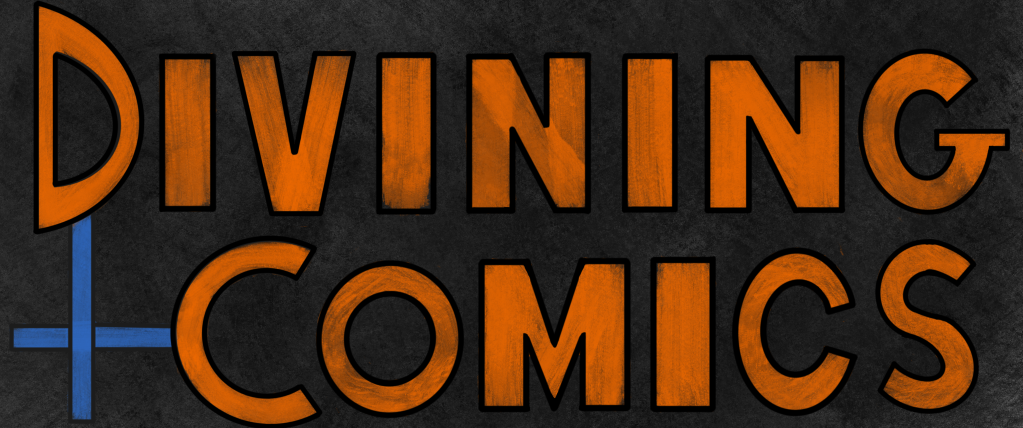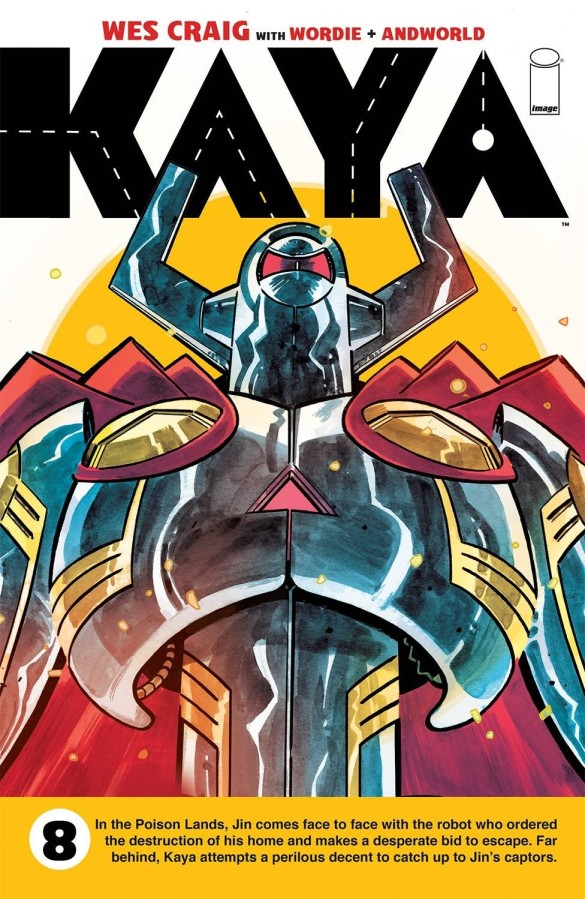Kaya # 8 and Voice Through Word Balloons
Comics are both a narrative and a visual magic. This is similar in some ways to film, but that is an audio-visual alchemy. Ever since the introduction of the talkies, films can pair together image and sound. Comics, other than the occasional one on the web, don’t have a sonic element. Words must be represented through image. The primary form this has taken in comics is the Word Balloon.
The word balloon is a fascinating artifact. It’s a visual representation of sound, an intrusion of the non-material into physical space. In another word, conjuration. Through a word balloon, hypothetical sound telepathically travels directly from the brains of the artists to the reader. Clever comic magicians can affect the shape of that mental message in several ways, such as font choice, word size, color, capitalization, bolds, italics, and so many other ways it would be a titanic task to list them. Today, however, I’m going to show you how this is done through the shape of the balloons. Kaya # 8, written and drawn by Wes Craig, colored by Jason Wordie, and most relevantly for today, lettered by Andworld’s Tom Napolitano, is an excellent example of just how much can be communicated merely through choice of word balloons.

Pictured here is a perfectly ordinary character, Nepta the amphibian prince. As of yet in the series, has no real distinguishing characteristics. Look at their word balloon (I’ve removed all of the actual words in the balloons to make today’s analysis more clear.) This is the cleanest, most basic word balloon in Kaya. Without the letters, it’s just a big white blob. There isn’t even an outline around the balloon, instead getting its shape entirely from negative space. The “tail” of the word balloon straightforwardly points to the speaker’s mouth. I don’t think a simpler word balloon is possible. This gets the job done for the vast majority of comic books.

The lizard rider Seth has a pretty similar word balloon. You could be forgiven for not immediately noticing the difference between this and the previous example. However, look at the tail: it has a bend in it. Visually, the tail looks like a snake. Once you notice this, it becomes apparent that most all of the lizard riders’s word balloons have a similar slither to them. Unlike the ordinary Nepta, Seth and the lizard riders perhaps have a serpentine lisp. By giving a fun bend to the tail, the sound that plays in your mind as you read Seth’s dialog changes.

Once again, the difference is in the tail. Every time Kaya, our title character and protagonist, speaks, her word balloon’s tail has a flat, rectangular tail. This fits her Spartan and pragmatic sensibilities. Kaya is blunt and direct. Her word balloons call to mind her enhanced fist, a knuckle of dialog. This is a little more abstract than the lizard’s lisp, but I think it might also affect the sound of Kaya’s voice. Words probably aren’t her strong suit. I doubt she has a pretty voice. But, taking a guess, I don’t think I’d ever be confused as to Kaya’s intent.

Here, we get something completely different. The mutant Prince Zewl, a major antagonist of the series so far, has an outline on his word balloon! After a series where every character’s word balloon was solely negative space, this more traditional lined balloon jumps out. The reader has to assume this matches his voice. He is big, threatening, and monstrous. All of the mutants have similar balloons. Notice also the imperfect line of the balloon, with wavering thickness and rough imperfections. The mutants are big and loud, yes, but also abrasive.

Building upon this is Zewl’s uncle. Like Zewl, the uncle is a mutant. There is something about this species perhaps that is conveyed by the thick outlined balloon. In addition to the rough outlines, the uncle gets a deformed, wrinkled tail. It is similar to the curl of the lizard rider’s balloons, but it is a less smooth curve, with almost a jitter to it. Zew’s uncle is monstrous, yes, but perhaps in less of a physical manner. When he speaks, his voice is presumably aged and weaker than it once was.

The most unique word balloon of the issue comes from Lord Vox. Another major antagonist of the series, his robotic voice matches his word balloon. There are several things to note, in addition to the not pictured unique font and occasional ERROR plastered over the dialog. His balloon is boxy and not round. The tail has a bend to it, like Seth and the lizard riders’s balloons, but here the tail bend is sharp angles and straight lines. This calls to mind the absoluteness of binary, either one or zero, horizontal or vertical. It is always colored grey, unlike the usual white for other characters. If you somehow didn’t guess it, Lord Vox is a robot. He is so mechanical that his voice sounds like nothing else in the comic, and that is shown visually through the balloon.
The final two examples I have are variants on balloons already shown. If you’ve ever read any comics from before the year 2000, you might be familiar with thought balloons, which, instead of depicting dialog, depict inner thoughts with more cloud-shaped balloons. Kaya 8 has two balloons that play with the form in a similar manner.
As our heroes fall to their danger, their word balloons change. First, at the top of the panel Seth’s balloon gets a little squiggly line beneath his words. This indicates the way his speech is cut off when he hits a branch. That squiggle is matched by the balloons of the other two, which both have a break in their curves for a small double-arch M. That meaning there is a little more up to interpretation. Personally, it indicates both the broken-up nature of what they are saying and visually replicates the doppler effect of the sound changing as the characters fall away from the perspective. Finally, Kaya’s balloon has an exclamation mark that literally bursts through the barriers of her balloon. This is effect on top of effect on top of effect to really hammer home the physicality of their fall and how that manifests in their speech.


By contrast, I’ll conclude with a subtle effect. Jin has been captured and is at a low point in this arc. He is weak and submissive, hoping to escape by playing to the empathy of one of his captors. This weakness and his whispering to not alert the less friendly mutants are captured visually in Jin’s word balloons. The tails are broken, like a string of dashed Morse code. Simply by changing up Jin’s balloons, his voice in our head is altered to a whimper.
Good comic lettering is ironically often said to be silent. It’s a lot easier to notice bad examples than good ones. But, lettering, like all the elements of comics, are visual. The word balloons, and the words within them, take up space on the comic page. They are a vital part in the magic of comics, conjuring voice in a silent medium. Next time you read a comic, pay extra attention to the words and their balloons, taking time instead of skimming quickly. Noticing how the word balloons give voice to the characters will aid your journey in divining comics.
If you haven’t already, consider supporting this work at ko-fi.com/spikestonehand. There, you can leave a tip or buy Zine versions of these articles. Doing this helps keep the website going.


Leave a comment